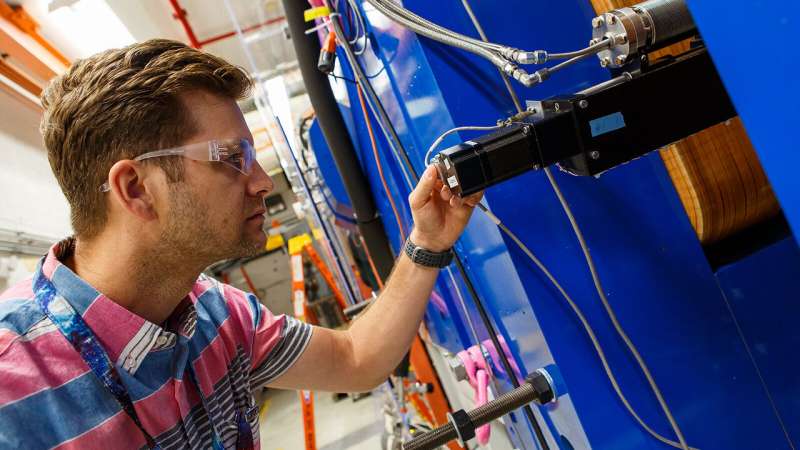Giving ATLAS a boost

The outer realms of the periodic table, where stable, long-lived isotopes give way to radioactive ions, offer nuclear scientists a unique glimpse into the structure of nuclei and a better understanding of how the different elements in our universe came to be as a result of stellar fusion or supernova explosions.
To produce and accelerate beams of radioactive isotopes for physics experiments, scientists turn to facilities like the Argonne Tandem Linear Accelerator System (ATLAS), a U.S. Department of Energy (DOE) Office of Science User Facility located at Argonne National Laboratory for the study of nuclear physics. Since the first successful acceleration of an ion beam by the prototype ATLAS facility in 1978, ATLAS has continued to introduce components that add unique beam selections and dramatically improve beam quality, including the recent additions of the Electron Beam Ion System (EBIS) and the Argonne In-Flight Radioactive Ion Separator (RAISOR).
ATLAS began its life primarily as a stable beam facility, but in the course of the past two decades scientists there have pioneered techniques to develop radioactive ion beams. In 2009, Argonne added to ATLAS a system called CARIBU, for Californium Rare Ion Breeder Upgrade, which is capable of generating beams of rare isotopes.
Getting CARIBU's beams ready for acceleration in ATLAS requires special preconditioning, said Argonne physicist Clay Dickerson. CARIBU works by slowing down decay products from a source of radioactive californium-252 in helium gas.
"It's like trying to run through a ball pit; the fragments lose some of their energy," Dickerson said. "With some clever manipulation, we can use magnets to select ions with the specific masses that we want." The CARIBU system can separate different isotopes so long as their masses differ by one part in 15,000.
Once nuclear physics researchers select a particular isotope beam, it must eventually be accelerated in ATLAS. To accomplish this, Dickerson and his colleagues outfitted ATLAS with the new EBIS, which enables the beam to match the accelerating structures by increasing the ion beam's positive charge.
The EBIS does this by shooting a high-energy electron beam at the ions, each of which have roughly 40 to 50 electrons. As the EBIS electron beam strips off the electrons surrounding the radioactive ions, the charge state of the ions becomes increasingly positive, allowing them to be efficiently accelerated.
While EBIS is good at preparing beams of relatively heavy isotopes—those with dozens of protons—the RAISOR facility gives scientists a way to examine those lighter isotopes toward the top of the periodic table. To generate these radioactive beams, researchers first have to start with a stable beam and then collide it with a target. Once they generate the beam of interest, nuclear physicists at ATLAS can perform further experiments with it downstream.
"This method—producing radioactive beams 'in-flight' – is convenient and versatile, and better enables the exploration of a significant portion of the near-stability, low-mass isotopes," Dickerson said.
Although RAISOR is not ATLAS's first in-flight beam production system, it addresses a number of challenges experienced with the previous system, which was primarily a prototype machine used to offer a proof of principle. For instance, RAISOR has a dedicated beam dump that can be used to absorb the beam used to create the radioactive beams, giving scientists a much easier way to control the power of the beam. "RAISOR really pushes our previous limitations further out so we can go to higher intensity and produce more beams," Dickerson said.
The recent enhancements of ATLAS with EBIS and RAISOR at ATLAS will help scientists probe the structures of exotic elements, study the nature of the nuclear forces, and better understand the production of elements in stars and supernovae.
Provided by Argonne National Laboratory



















